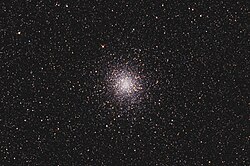Messier 22
| Kugelsternhaufen Messier 22 | |
|---|---|
 | |
| Panoramaaufnahme | |
| AladinLite | |
| Sternbild | Schütze |
| Position Äquinoktium: J2000.0, Epoche: J2000.0 | |
| Rektaszension | 18h 36m 24,21s [1] |
| Deklination | −23° 54′ 12,2″ [1] |
| Erscheinungsbild | |
| Konzentrationsklasse | VII [2] |
| Helligkeit (visuell) | 5,1[3] bzw. 6,17 mag [1] |
| Helligkeit (B-Band) | 7,16 mag [1] |
| Winkelausdehnung | 32,0' [4] |
| Physikalische Daten | |
| Rotverschiebung | (−494 ± 17) · 10−6 [1] |
| Radialgeschwindigkeit | (−148 ± 5) km/s [1] |
| Entfernung | 10,7 kLj [4] |
| Durchmesser | 97 Lj |
| Geschichte | |
| Entdeckung | Johann Abraham Ihle |
| Entdeckungsdatum | 26. August 1665 |
| Katalogbezeichnungen | |
| M 22 • NGC 6656 • C 1833-239 • GCl 99 • | |
Messier 22 (auch als NGC 6656 bezeichnet) ist ein 5,5 mag heller Kugelsternhaufen mit einer Flächenausdehnung von 32' im Sternbild Schütze. Er steht in Richtung des Milchstraßenzentrums, 2° nordöstlich des Sterns Lambda Sagittarii.
M22 ist der hellste von Europa aus sichtbare Kugelsternhaufen, steht allerdings tief am Südhimmel. Schon mit bloßem Auge als sternartiges Objekt sichtbar, ist er im Teleskop ein attraktives Deep-Sky-Objekt und fast so prächtig wie der bekannte Herkuleshaufen M13. Er besteht aus rund 80.000 Sternen, unter denen etwa 100 als veränderliche Sterne katalogisiert sind.
Aufgrund seiner Helligkeit wurde M22 auch als erster Kugelsternhaufen beobachtet: der deutsche Amateurastronom Johann Abraham Ihle nahm ihn am 26. August 1665[5] in seinem 2-Zoll-Fernrohr als rundes Nebelfleckchen wahr. Im Achtzöller werden von den hellsten Sternen (11 mag) einige Dutzend am Haufenrand erkennbar. 2001 beobachtete man Helligkeitsausbrüche, die durch eine Zwergnova oder durch Mikrolinseneffekte enger Sternbahnen erklärt wurden.[6]
Im September 2012 entdeckte ein internationales Forscherteam mit Hilfe des Very Large Array des US-amerikanischen Radioastronomie-Observatoriums NRAO, dass M22 mehr als ein Schwarzes Loch enthält, was bisher aus Gründen der Himmelsmechanik als ausgeschlossen galt. Die beiden Objekte haben jeweils 10 bis 20 Sonnenmassen.[7]
2019 wurden die Überreste einer 48 v. Chr. in China beobachteten Nova in M22 entdeckt.[8] Das bestätigte eine der ältesten aufgezeichneten Beobachtungen eines Ereignisses außerhalb des Sonnensystems. Zu sehen ist ein rötlicher Nebel mit einer Ausdehnung von 8000 AE. Die Beobachtungen erfolgten mit dem MUSE-Instrument des Very Large Telescope.
- (c) ESA/Hubble, CC BY 4.0Hochaufgelöste Aufnahme des Zentrums mithilfe des Hubble-Weltraumteleskops
- Infrarotaufnahme mithilfe des 4 Meter durchmessenden Teleskop VISTA
Literatur
- König, Michael & Binnewies, Stefan (2023): Bildatlas der Sternhaufen & Nebel, Stuttgart: Kosmos, S. 352
Weblinks
Einzelnachweise
- ↑ a b c d SIMBAD Astronomical Database
- ↑ NED data for the Messier Objects
- ↑ Koch/Korth, Die Messier-Objekte, Kosmos-Verlag 2009
- ↑ a b Messier 22 bei SEDS
- ↑ klima-luft.de: Johann Abraham Ihle, abgefragt am 25. August 2011
- ↑ Koch/Korth, Die Messier-Objekte, Kosmos-Verlag 2009
- ↑ Erstmals Schwarze Löcher in Kugelsternhaufen entdeckt. In: Zeit Online. Zeit Online GmbH, 3. Oktober 2012, abgerufen am 4. Oktober 2012.
- ↑ Observation including Göttingen participation confirms one of the oldest Chinese measurements, Universität Göttingen, 29. April 2019
Auf dieser Seite verwendete Medien
Autor/Urheber: ESO/VVVX survey, Lizenz: CC BY 4.0
This is an infrared view of the Messier 22 globular cluster, a densely packed group of very old stars located about 10 000 light-years away in the constellation Sagittarius. The image was taken with ESO’s VISTA ― the Visible and Infrared Survey Telescope for Astronomy ― and its infrared camera VIRCAM. It is part of a record-breaking infrared map of the Milky Way containing more than 1.5 billion objects. The data were gathered as part of the VISTA Variables in the Vía Láctea (VVV) survey and its companion project, the VVV eXtended survey (VVVX).
Bildtafel der 110 Messier-Objekte. Diese Datei wird in der w:de:Template:Navigationsleiste Messierobjekte als Imagemap genutzt. Sie darf daher nicht durch eine andere Version überschrieben werden!
(c) ESA/Hubble, CC BY 4.0
This image shows the centre of the globular cluster Messier 22, also known as M22, as observed by the NASA/ESA Hubble Space Telescope. Globular clusters are spherical collections of densely packed stars, relics of the early years of the Universe, with ages of typically 12 to 13 billion years. This is very old considering that the Universe is only 13.8 billion years old. Messier 22 is one of about 150 globular clusters in the Milky Way and at just 10 000 light-years away it is also one of the closest to Earth. It was discovered in 1665 by Abraham Ihle, making it one of the first globulars ever to be discovered. This is not so surprising as it is one of the brightest globular clusters visible from the northern hemisphere, located in the constellation of Sagittarius, close to the Galactic Bulge — the dense mass of stars at the centre of the Milky Way. The cluster has a diameter of about 70 light-years and, when looking from Earth, appears to take up a patch of sky the size of the full Moon. Despite its relative proximity to us, the light from the stars in the cluster is not as bright as it should be as it is dimmed by dust and gas located between us and the cluster. As they are leftovers from the early Universe, globular clusters are popular study objects for astronomers. M22 in particular has fascinating additional features: six planet-sized objects that are not orbiting a star have been detected in the cluster, it seems to host two black holes, and the cluster is one of only three ever found to host a planetary nebula — a short-lived gaseous shells ejected by massive stars at the ends of their lives.








